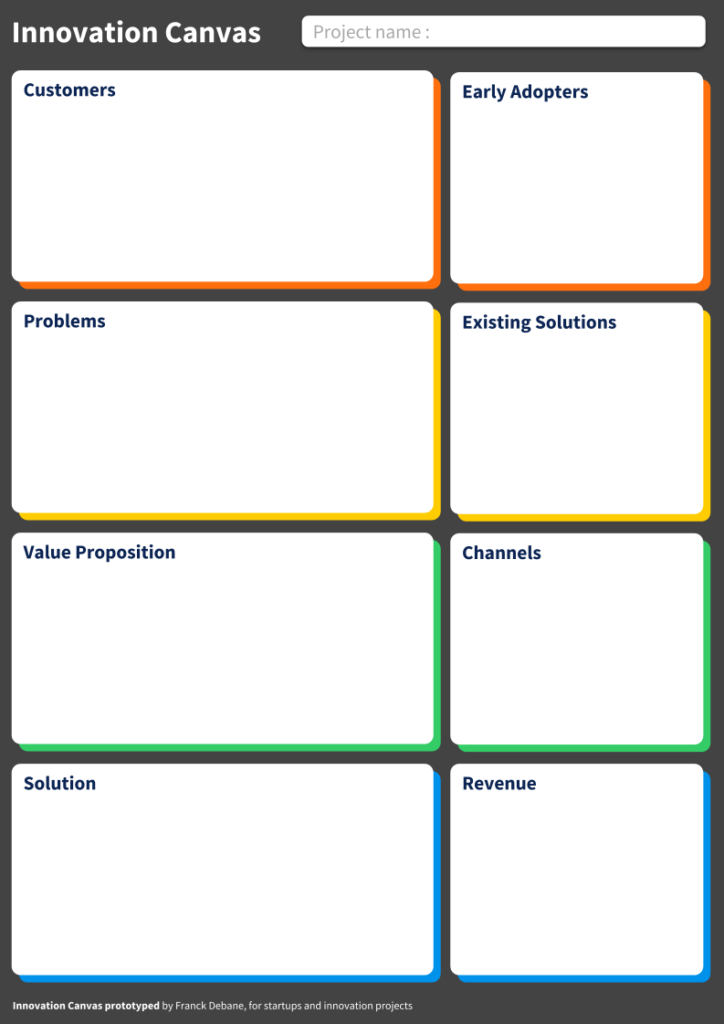
Starting on the right track with the Innovation Canvas
Over the past years, I have used both the Business Model Canvas and the Lean Canvas on hundreds of projects. Those canvases have helped me structure my thinking and really understand the mechanics of business models and innovation. Those powerful models played a key role in my understanding of value creation and businesses today. However, while I found some components in those canvases are very useful, some others tend to shift the conversation away from what matters most in innovation: the customers and their problems.
As a result, I started testing various evolutions of those canvases on innovation project and startups. Removing what was in the way and magnifying what was useful. Iteration after iteration, I finally arrived at this canvas which I call simply the Innovation Canvas.
Here is how it looks like:

The logic behind the Innovation Canvas
This canvas very simply includes the key questions you need to answer when starting an innovation project. Each element fits into a block. Here is the order to address them:
- Who are your customers
- What problem are you solving for them
- What is your value proposition
- What is your solution
The top two blocks are about the problem space and the two blocks at the bottom are about the solution space. The problem space and the solution space are connected in the middle by the problem and the value proposition. The value proposition is often mirroring the problem. When the value proposition is accepted by the customer, he uses your product or service.
The 4 secondary blocks are:
From your customer, you identify the early adopters.
From the problem, you learn the existing solutions.
From the value proposition, find the channels to reach your customers and test your value proposition.
From the solution, think of the revenues, based on the value you are creating for your customers.
How to fill the Innovation Lean Canvas
Start from left to right and fill in the blocks as precisely as possible. Here is what every block means:
- Customer Segments: What are the different customer segments that are going to use or buy your solution? You want to be as precise as possible and define segments not by demographics (ex: 20–25-year-old living in the suburbs) but by behaviors (ex: backpackers traveling twice a year).
- Early Adopters: Who will be the first customers to use your product? This is directly connected to who suffers the most from the problems identified. Later you can make a persona of your early adopters.
- Problems: What problems do you want to solve for those customers? List them all. Then, you can focus on the one that looks more important. Stay away from problems such as “no time” or “too expensive”.
- Existing Solutions: Today, how are customers solving the problems you want to solve? What other products or solutions are they using? These are the competitors of your solution. Are your potential customers happy with the existing solutions?
- Value Proposition: The message to the customers on the value you will deliver them. I found that it helps to frame the value proposition as the opposite of the problem. If the problem you are solving is “Small businesses having a hard time finding reliable local designers”, your value proposition might be: “Find a reliable local designer for your business”. Customers should be able to quickly know if this is something they are interested in or not.
- Channels: How will you get your first customers? Via which channel? You know you need to talk to customers but where to find them, how to reach them? In this block, list the channels you can use.
- Your Solution: How your solution is solving the customer’s problems? You can describe your solution and list the features.
- Revenue: How will you make money? A percentage of the transaction. A monthly fee? Use this to estimate how many customers or transactions it will take to make the first millions in turnover. This will give you a sense of the viability of your idea.
Once you have those key elements identified, you can start testing the different parts of your ideas. How? Well, this is another story that we can cover later 🙂
You can download the Innovation Canvas on Tango’s website. If you give it a try, please let me know how it works for you. Contact me on Linkedin
If you are in Paris, you can join +10.000 innovators in the Lean Startup Experience community on Meetup where we discuss and explore those topics.